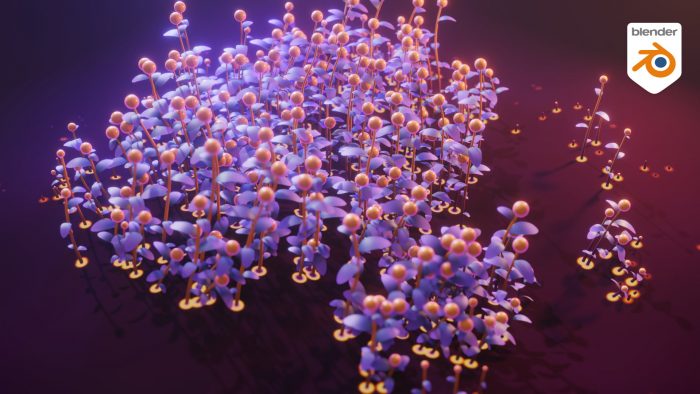Transferring data between DCCs is a cumbersome but necessary task. Particles are not yet supported via nodes inside of Blender for example and usually come in from somewhere else. In this tutorial Manuel shows you how to create a surface flow particle effect inside of […]
All Posts tagged “Instances”
Geometry Nodes 3.0 – Plant Growth with Fields
Now that Blender 3.0 is in beta it is time for a little more advanced setup. In this tutorial Manuel will build a multi-layered growth effect. Fully procedural plants are scattered on a procedural terrain and controlled by an effector empty. They all grow individually […]
Geometry Nodes 3.0 – Cube Grid with Fields
The Geometry Nodes Team decided to redo the architecture of Geometry Nodes for the Blender 3.0 release. Fortunately we can have a look at the new way of working immediately by using the 3.0 Alpha. This tutorial creates a similar effect as my older Cube […]
Cube Grid – Use Color on Geometry Nodes Instances
Geometry Nodes inside of Blender is constantly updated and expanded on. Using the latest Blender 3.0 Alpha we can now transfer color to geometry generated through instances. This wasn’t possible before and opens a wide range of possibilities for creative expression in Blender. Follow Manuel […]
Create a Reveal Effect in Blender Geometry Nodes using Linear Falloff
Although Geometry Nodes does not support simulation yet, we can still use it to create effects that look like particles. In this tutorial you’ll learn how to implement a linear falloff using the dot product to control a lot of instances procedurally, We’ll then use […]
Keycap Sculptures (Disco Ball Tiling)
When we received an E-Mail by Eduard, asking if we had any idea about disco ball packing, we were intrigued. Eduard pointed out that his (apparently very patient) wife manually tiled this sculpture and was wondering if there’s any way to automate it. He also […]
Rendering 101 – pt. 22: Using Redshift Proxies
To view this content, you must be a member of Entagma’s Patreon at $29 or more
Rendering 101 – pt. 21: Instancing In Redshift (Plus A Bit Of Shading)
To view this content, you must be a member of Entagma’s Patreon at $29 or more
Houdini In Five Minutes 19: SOPs, Redshift & MOPs – Isocontours: Setting Up The Rendering
In our final project for this first sprint of “Houdini in five minutes” we’re gonna build a tactical shooter style isocontour map with a bunch of moving particles. We’re gonna be using Houdini’s built in SOPs, a bit of MOPs (www.motionoperators.com) and Redshift (www.redshift3d.com). In […]
Houdini In Five Minutes 18: SOPs, Redshift & MOPs – Isocontours: Setting Up The Particles
In our final project for this first sprint of “Houdini in five minutes” we’re gonna build a tactical shooter style isocontour map with a bunch of moving particles. We’re gonna be using Houdini’s built in SOPs, a bit of MOPs (www.motionoperators.com) and Redshift (www.redshift3d.com). In […]
Houdini In Five Minutes 17: SOPs, Redshift & MOPs – Isocontours: Setting Up The Terrain
In our final project for this first sprint of “Houdini in five minutes” we’re gonna build a tactical shooter style isocontour map with a bunch of moving particles. We’re gonna be using Houdini’s built in SOPs, a bit of MOPs (www.motionoperators.com) and Redshift (www.redshift3d.com). In […]
Houdini In Five Minutes 16: Building A Flip Display Using MOPs
Let’s put our newfound knowledge of packed primitives and the MOPs toolkit to use and build a straightforward mechanical display! Download Motion Operators for free. Download Project File
Houdini In Five Minutes 15: Packed Primitives (Theory)
Let’s dive into our last bunch of videos in this first sprint of “Houdini in five minutes” with a seemingly dry topics: Packed Primitives / Instances. Although slightly technical, it’s a powerful concept that enables Houdini to work on massive scenes.
Quicktip: Instancing In Redshift (Bonus: Particle Advection)
Last week Germany was still under a massive heat wave. And an office doesn’t get colder by running smoke sims and rendering. That’s why I had to keep this one relatively short (let’s call it a speedrun): We’ll build a particle system advected by a […]











